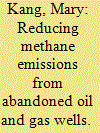| Srl | Item |
| 1 |
ID:
111447


|
|
|
|
|
| Publication |
2012.
|
| Summary/Abstract |
The Intergovernmental Panel on Climate Change gave a methodology to estimate the methane emissions from Municipal Solid Wastes landfills, based on a First Order Decay (FOD) model that assumes biodegradation kinetics depending on the type of wastes. This model can be used to estimate both the National greenhouse gas emissions in the industrialized countries as well as the reductions of these emissions in the developing ones when the Clean Development Mechanism, as defined by the Kyoto Protocol, is implemented. In this paper, the FOD model has been use to evaluate the biogas flow rates emitted by a Brazilian landfill and the results have been compared to the extracted ones: some first results can be useful to evidence the weight of key parameters and do a correct use of the model.
|
|
|
|
|
|
|
|
|
|
|
|
|
|
|
|
| 2 |
ID:
166999


|
|
|
|
|
| Summary/Abstract |
Well plugging, the main strategy for reducing methane emissions from millions of unplugged abandoned oil and gas (AOG) wells in the U.S. and abroad, is expensive and many wells remain unplugged. In addition, plugging does not necessarily reduce methane emissions and some categories of plugged wells are high emitters. We analyze strategies and costs of five options for reducing methane emissions from high-emitting AOG wells - those which are unplugged and plugged/vented gas wells. The five options are: plugging without gas venting, plugging with gas venting and flaring, plugging with gas venting and usage, gas flaring only, and gas capture/usage only. Average plugging costs ($37,000 per well) can be justified by the social cost of methane, which considers air quality, climate, and human/ecosystem impacts. Savings as measured by natural gas prices and alternative energy credits can offset low plugging costs (<$15,400 per well) but are not large enough to offset average plugging costs. Nonetheless, reducing methane emissions from AOG wells is a cost-effective strategy for addressing climate change that has comparable costs to some current greenhouse gas mitigation options and can produce co-benefits such as groundwater protection. Therefore, we recommend including the mitigation of AOG wells in climate and energy policies in the U.S., Canada, and other oil-and-gas-producing regions.
|
|
|
|
|
|
|
|
|
|
|
|
|
|
|
|